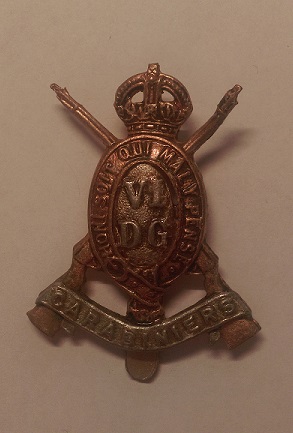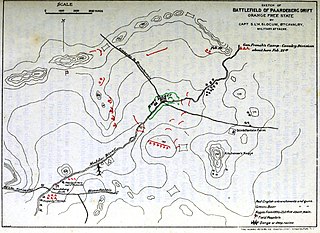
Pieter Arnoldus "Piet" Cronjé was a South African Boer general during the Anglo-Boer Wars of 1880–1881 and 1899–1902.

General Sir Redvers Henry Buller, was a British Army officer and a recipient of the Victoria Cross, the highest award for gallantry in the face of the enemy that can be awarded to British and Commonwealth forces. He served as Commander-in-Chief of British Forces in South Africa during the early months of the Second Boer War and subsequently commanded the army in Natal until his return to England in November 1900.

Bloody Sunday of February 18, 1900, was a day of high Imperial casualties in the Second Boer War.

Colonel Sir Percival Scrope Marling, 3rd Baronet, VC, CB, DL was an English British Army officer and recipient of the Victoria Cross, the highest and most prestigious award for gallantry in the face of the enemy that can be awarded to British and Commonwealth forces.
Jacobsdal is a small farming town in the Free State province of South Africa with various crops under irrigation, such as grapes, potatoes, lucerne, and groundnuts. The town was layout in 1859 by Christoffel Jacobs on his farm Kalkfontein, and today houses 3,504 inhabitants.

The Battle of Maiwand, fought on 27 July 1880, was one of the principal battles of the Second Anglo-Afghan War. Under the leadership of Ayub Khan, the Afghan forces defeated a much smaller British force consisting of two brigades of British and Indian troops under Brigadier-General George Burrows, albeit at a high price: between 2,050 and 2,750 Afghan warriors were killed, and probably about 1,500 wounded. British and Indian forces suffered 969 soldiers killed and 177 wounded.

The Carabiniers (6th Dragoon Guards) was a cavalry regiment of the British Army. It was formed in 1685 as the Lord Lumley's Regiment of Horse. It was renamed as His Majesty's 1st Regiment of Carabiniers in 1740, the 3rd Regiment of Horse (Carabiniers) in 1756 and the 6th Regiment of Dragoon Guards in 1788. After two centuries of service, including the First World War, the regiment was amalgamated with the 3rd Dragoon Guards (Prince of Wales's) to form the 3rd/6th Dragoon Guards in 1922.

The Battle of Paardeberg or Perdeberg was a major battle during the Second Anglo-Boer War. It was fought near Paardeberg Drift on the banks of the Modder River in the Orange Free State near Kimberley.

The Battle of Magersfontein was fought on 11 December 1899, at Magersfontein, near Kimberley, South Africa, on the borders of the Cape Colony and the independent republic of the Orange Free State. British forces under Lieutenant General Lord Methuen were advancing north along the railway line from the Cape to relieve the siege of Kimberley, but their path was blocked at Magersfontein by a Boer force that was entrenched in the surrounding hills. The British had already fought a series of battles with the Boers, most recently at Modder River, where the advance was temporarily halted.

The 10th Royal Hussars (Prince of Wales's Own) was a cavalry regiment of the British Army raised in 1715. It saw service for three centuries including the First World War and Second World War but then amalgamated with the 11th Hussars (Prince Albert's Own) to form the Royal Hussars (Prince of Wales's Own) in October 1969.

The 20th Hussars was a cavalry regiment of the British Army. After service in the First World War it was amalgamated with the 14th King's Hussars to form the 14th/20th King's Hussars in 1922.

The First and Second Battles of El Teb took place during the British Sudan Campaign where a force of Sudanese under Osman Digna won a victory over a 3,500 strong Egyptian force under the command of General Valentine Baker which was marching to relieve Tokar on the 4th. A second British force under Sir Gerald Graham arrived on the 29th, engaging and defeating Osman Digna with few casualties.

The Battle of Tamai took place on 13 March 1884 between a British force under Sir Gerald Graham and a Mahdist Sudanese army led by Osman Digna.

The siege of Kimberley took place during the Second Boer War at Kimberley, Cape Colony, when Boer forces from the Orange Free State and the Transvaal besieged the diamond mining town. The Boers moved quickly to try to capture the area when war broke out between the British and the two Boer republics in October 1899. The town was ill-prepared, but the defenders organised an energetic and effective improvised defence that was able to prevent it from being taken.

Daniël Johannes Stephanus "Danie" Theron was a Boer Army military leader and master scout. Born in Tulbagh, Cape Colony, he was raised in Bethlehem, Orange Free State. He is best known as the driving force behind the formation of a military bicycle corps used by the Boer Army for scouting and relaying messages. Originally trained as a school teacher, he became a lawyer and notary with his own law firm in Krugersdorp, Transvaal Republic, and was made a commandant in the Boer forces during the Second Anglo-Boer War. During the course of the war, he was put in charge of a significant scouting unit, Theron se Verkenningskorps (TVK). He fought at the Battle of Spion Kop and one of his most famous feats occurred at the Battle of Paardeberg. The British Commander in Chief, Lord Roberts, called Theron: "the hardest thorn in the flesh of the British advance", put a reward of £1,000 on his head – dead or alive – and dispatched 4,000 soldiers to find and eliminate the TVK.

Richard Caton Woodville Jr. was an English artist and illustrator, who is best known for being one of the most prolific and effective painters of battle scenes in the late 19th and early 20th centuries.

The Battle of Poplar Grove was an incident on 7 March 1900 during the Second Boer War in South Africa. It followed on from the Relief of Kimberley as the British Army moved to take the Boer capital of Bloemfontein. The Boers were demoralised following the surrender of Piet Cronjé at the Battle of Paardeberg. General Sir John French's cavalry attacked the Boer force from the rear while mounted infantry and horse artillery attacked from the right flank. The Boers abandoned their positions in panic before the cavalry. The commander-in-chief of the Free State forces, Christiaan de Wet, in his book called the chapter on the subject "Wild Flight from Poplar Grove".

William Barnes Wollen was an English painter mostly known for his paintings of battle and historical scenes and sporting events.
James Prinsep Beadle was an English painter of historical and military scenes.

HorsePower: The Museum of the King's Royal Hussars is a military museum in Winchester, Hampshire, that is dedicated to documenting the King's Royal Hussars, a cavalry regiment of the British Army. The museum is one of the founding members of Winchester's Military Museums, a partnership of six museums located in the Peninsula Barracks, Winchester. The museum contains exhibits spanning three centuries of two of the Royal Hussar regiments; the 10th Royal Hussars and the 11th Royal Hussars, as well as the Royal Hussars, which became The King's Royal Hussars in 1992.

















